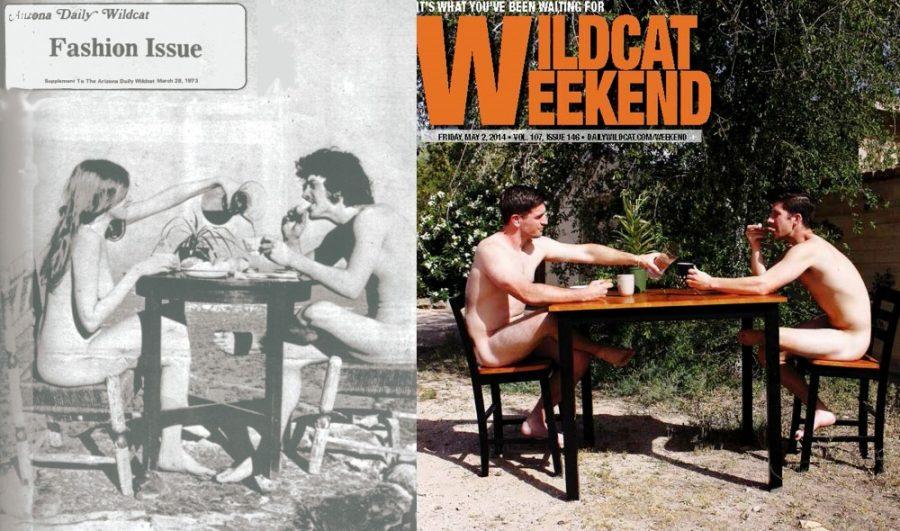Fashion is constantly changing, morphing, recycling and innovating. It’s an art form and an expression; whether you know it or not, fashion trends influence your decisions every morning when you put on your clothes.
This spring season sky-high wedges, crop tops and midi’s are must-haves, according to Harper’s Bazaar. Pair those with high-waisted shorts or wide-legged pants and you’ll be right on trend. In-style colors range from pale pastels to flirty florals, and of course include the bold classics such as deep reds and royal blues.
One thing that’s certain is that the past has had an undeniable impact upon this season’s getup. The era that is most notably inspiring today’s trends, from crop tops to wide-legged pants, is the ’70s. To commemorate this at the Wildcat, we decided to pull one of our most memorable relics from that era and remake it with a 21st-century twist. When first coming upon this cover in the archives, the word that came to mind was “bold.” And what is fashion, if not bold?
Tim Fuller, the man behind the original shoot, a former Wildcat photo editor, retells the story behind the controversial cover:
I learned more about photography and how to communicate ideas with photographs in the year I was the photo editor at the Wildcat than in any other year in my life. At the San Francisco Art Institute I had learned how to craft photographs that expressed myself. At the Wildcat, I learned how to make photographs tell stories.
One day early in 1973, when I was the Wildcat photo editor, I was told by the newspaper’s business manager that I had to shoot a fashion supplement for the paper.
Shooting sorority girls wearing preppy clothes seemed like a stupid idea to me. At that point the country was still involved in the Vietnam War and I told the business manager how ridiculous it was to devote 32 pages to a fashion spread. He said that he didn’t really care a lot how I felt about doing it. He had sold the ads and I needed to shoot it.
I said that I would, but that I wanted him to stay out of the way. Sure, he said. It was one less thing for him to worry about.
The morning the Arizona Daily Wildcat fashion supplement was printed, Stan Turley, Arizona Senate president, held a copy of it in his right hand. It was raised over his head and he seemed irritated. He wanted to cut $6 million from the budgets of the three state universities (I think his words were) “if they can’t control their students better than this.”
I had wondered, if a fashion supplement is about clothing, where do you start the story? Seemed obvious: Start without clothing. And at the beginning of the day you have to eat breakfast. I also thought that it would be an even better idea if this breakfast table was somewhere pretty, somewhere that warmly reminded our readership of this lovely desert we lived in.
It wasn’t too hard for my actor friends Rebecca and Ritch and I to carry a small table with the breakfast food to the top of the hill at Gates Pass. Then Rebecca and Ritch sat facing each other across the table and ate cereal and fruit and drank juice while I took photographs.
“Need a good vertical for the cover,” I thought, “with room for the masthead at the top.” There wasn’t even a hint of what I at age 6 thought was called public hair. Not a body part visible that couldn’t have been seen in any daily newspaper in America. But they were naked, obviously and entirely naked.
What a day it was! The forces of truth in Phoenix, not content to concern themselves with the obvious immorality of this sophomoric prank, whipped up bonus indignation by pointing out the anti-war editorials being written by our “Commie traitor” editor Jay Parker (later to become Colonel Jay Parker, the director of International Relations & National Security Studies at the United States Military Academy). By that afternoon our newsroom was filled with TV cameras and reporters and the basic theme of the day was, if they fool with the Wildcat, they are messing with freedom of the press. We became “press heroes” and there were few people in southern Arizona that didn’t know, and giggle slightly, about what we had managed to pull off.
@xoTatianaTom__









